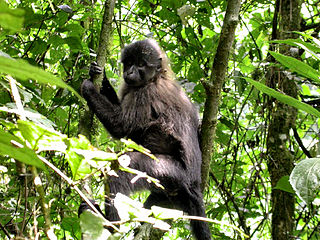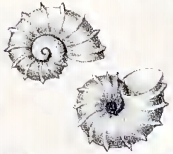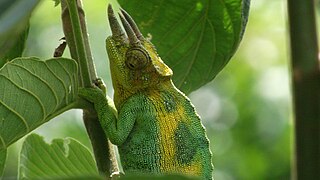
The okapi, also known as the forest giraffe, Congolese giraffe, or zebra giraffe, is an artiodactyl mammal native to the northeast Democratic Republic of the Congo in central Africa. Although the okapi has striped markings reminiscent of zebras, it is most closely related to the giraffe. The okapi and the giraffe are the only living members of the family Giraffidae.
Catopsalis is a genus of extinct mammal from the Paleocene of North America. This animal was a relatively large member of the extinct order of Multituberculata. Most Multituberculates were much smaller.

The freshwater crocodile, also known as the Australian freshwater crocodile, Johnstone's crocodile or colloquially as freshie, is a species of crocodile endemic to the northern regions of Australia.

Astrodon is a dubious genus of large herbivorous sauropod dinosaur, related to Brachiosaurus, that lived in what is now the eastern United States during the Early Cretaceous period. Its fossils have been found in the Arundel Formation, which has been dated through palynomorphs to the Albian about 112 million years ago. Adults are estimated to have been more than 9 m (30 ft) high and 15 to 18 m long.

Johnston's genet is a genet species native to the Upper Guinean forests. As it is threatened by deforestation and conversion of rainforest to agriculturally and industrially used land, it is listed as Near Threatened on the IUCN Red List.

The Uganda mangabey is a species of Old World monkey found only in Uganda and in the Minziro Forest Reserve, just over the border in Tanzania. This crested mangabey was previously thought to just be a population of the grey-cheeked mangabey. Colin Groves upgraded the Ugandan population to the new species L. ugandae on 16 February 2007. This species is significantly smaller than the grey-cheeked mangabey, with a shorter skull and smaller face. 2008 was the most recent year in which the International Union for Conservation of Nature assessed the conservation status of L. albigena, describing it as being of least concern, and the status of L. ugandae has not been assessed separately.

Petropedetes is a genus of frogs in the family Petropedetidae. In 2002, the genus absorbed all three species of the genus Arthroleptides, but they were moved back in 2014. The informally assigned common name for frogs in this genus is torrent frogs.

Petropedetes johnstoni is a species of frog in the family Petropedetidae. It is endemic to coastal Cameroon and known with certainty only from few localities. For a period, Petropedetes newtonii was considered a junior synonym of this species, leading to a much broader distribution. The two species are now considered distinct, but information on Petropedetes johnstonisensu stricto is limited. Common name Johnston's water frog has been coined for this species.

The Rwenzori turaco is a bird in the family Musophagidae. It is native to the Albertine Rift montane forests.

The scarlet-tufted sunbird is a species of bird in the Nectarinia of the family Nectariniidae. It is found in Democratic Republic of the Congo, Kenya, Malawi, Rwanda, Tanzania, Uganda, and Zambia. It is also known as the red-tufted sunbird and the scarlet-tufted malachite sunbird.
The Johnston's African dormouse is a species of rodent in the family Gliridae. It is found in Malawi, Zambia, and Zimbabwe. Its natural habitat is moist savanna.

The forest shrews are the members of the genus Sylvisorex. They are mammals in the family Soricidae and are found only in Africa. The genus name comes from the Latin world "silva" which means "forest" and "sorex", which means "shrew-mouse". This reflects the nature of these shrews, which prefer forest habitats. All shrews are carnivorous, and eat continually to satisfy their high metabolic rate.

Johnston's forest shrew is a species of mammal in the family Soricidae found in Burundi, Cameroon, the Central African Republic, the Republic of the Congo, the Democratic Republic of the Congo, Equatorial Guinea, Gabon, Rwanda, Tanzania, and Uganda. Its natural habitats are subtropical or tropical moist lowland forest and subtropical or tropical moist montane forest. It is threatened by habitat loss.
The Clarence galaxias is a species of fish in the family Galaxiidae endemic to Tasmania.

Liotella is a genus of minute sea snails or micromolluscs, marine gastropod molluscs in the family Skeneidae.

Trioceros johnstoni, known commonly as Johnston's chameleon, Johnston's three-horned chameleon, or the Ruwenzori three-horned chameleon, is an endemic chameleon of the Albertine Rift in Central Africa.
Catatropis johnstoni is a fluke from the United States. It was first described in 1956 by Martin, who had found cercariae released by the snail Cerithidea californica in southwestern California. When the cercaria were fed into chickens, they developed into mature worms; Martin speculated that the natural host was a waterbird. In 1970, a study of helminths of the marsh rice rat in a saltmarsh at Cedar Key, Florida, found flukes similar to C. johnstoni. The fluke was present in 30% of 110 examined rice rats, with the number of worms per rat varying from 1 to 500. Some Cerithidea scalariformis snails from this marsh also released cercariae similar to C. johnstoni from California. When introduced into chickens, marsh rice rats, Mongolian gerbils, golden hamsters, and house mice, these cercariae developed into infectious flukes. Bush and Kinsella, who reported on the result in 1972, regarded the Florida and California flukes as the same species, as there were only minor size differences between them. Because no marsh-inhabiting rodent occurs in both California and Florida, they agreed with Martin that the normal host of C. johnstoni was most likely a bird, perhaps a rail or shorebird. Nevertheless, the rate of infection in the rice rat is too high for it to be just an accidental host; perhaps C. johnstoni is restricted to saltmarshes but not host-specific.

Colotis eris, the banded gold tip or black-barred gold tip, is a butterfly of the family Pieridae. It is found in the Afrotropical realm.

Heteroclinus johnstoni, or Johnston's weedfish, is a species of clinid native to the waters along the around southern Australian coast where it prefers reefs with tall seaweed growth at depths down to about 50 metres (160 ft). This species can reach a maximum length of 40 centimetres (16 in) TL. The specific name honours the statistician and scientist Robert Mackenzie Johnston (1843-1918).

Acraea johnstoni, or Johnston's acraea, is a butterfly in the family Nymphalidae. It is found in southern Sudan, northern Uganda, Ethiopia, Kenya, Tanzania, Malawi, Zambia, western Mozambique and eastern Zimbabwe. The habitat consists of montane forests.















